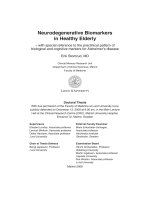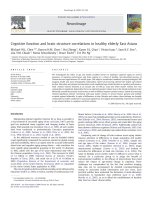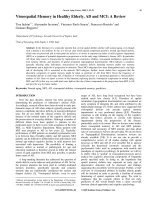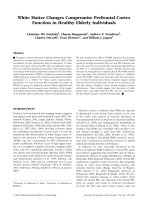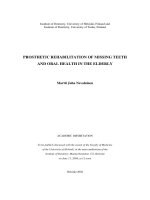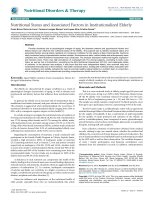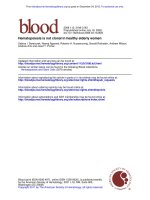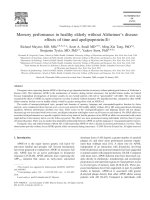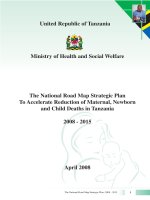Stress symptoms and coping strategies in healthy elderly subjects pot
Bạn đang xem bản rút gọn của tài liệu. Xem và tải ngay bản đầy đủ của tài liệu tại đây (136.57 KB, 7 trang )
801
Rev Esc Enferm USP
2009; 43(4):801-7
www.ee.usp.br/reeusp/
Stress symptoms and coping strategies
in healthy elderly subjects
Souza-Talarico JN, Caramelli P, Nitrini R, Chaves EC
Stress symptoms and coping
strategies in healthy elderly subjects
SINTOMAS DE ESTRESSE E ESTRATÉGIAS DE COPING EM IDOSOS SAUDÁVEIS
SÍNTOMAS DE ESTRÉS Y ESTRATEGIAS DE COPING EN ANCIANOS SALUDABLES
1
Nurse. Ph.D. Adjunct Professor at Nursing and Medicine Department, Jundiaí Faculty of Medicine. Jundiaí, SP, Brazil.
2
Neurologist. Ph.D. Adjunct
Professor at Internal Medicine Department, Faculty of Medicine at federal University of Minas Gerais. Belo Horizonte, MG, Brazil.
3
Neurologist.
Ph.D. Assocaite Free-Lecturer Professor at Neurology Department, Faculty of Medicine, University of São Paulo. São Paulo, SP, Brazil.
4
Nurse.
Ph.D. Professor at Department of Medical-Surgical Nursing, School of Nursing, University of São Paulo. São Paulo, SP, Brazil.
ORIGINAL ARTICLE
Received: 08/22/2008
Approved: 02/05/2009
Portuguese / English:
www.scielo.br/reeusp
RESUMO
Idosos podem manifestar sintomas de es-
tresse em decorrência das mudanças bio-
psicossociais do envelhecimento. O objeti-
vo deste estudo foi identificar sintomas de
estresse em idosos e o estilo de coping uti-
lizado por eles, verificando a relação entre
estas variáveis. Foram aplicados a Lista de
Sintomas de Stress (LSS) e o Inventário de
Coping de Jalowiec, em 41 idosos saudá-
veis. Os idosos apresentaram sintomas de
estresse, com intensidade média de 42.8
pontos. Observou-se predomínio do coping
focado no problema, porém não houve di-
ferença significativa entre as médias dos
escores do LSS entre os indivíduos que uti-
lizaram coping focado no problema ou na
emoção (p=0.737). Neste estudo, embora
os idosos tendessem a eleger o coping
focado no problema, a intensidade dos sin-
tomas de estresse independeu do tipo de
coping utilizado, evidenciando que tanto o
coping focado no problema como o focado
na emoção estão associados a níveis seme-
lhantes de estresse.
DESCRITORES
Estresse.
Idoso.
Adaptação psicológica.
Juliana Nery de Souza-Talarico
1
, Paulo Caramelli
2
, Ricardo Nitrini
3
, Eliane Corrêa Chaves
4
ABSTRACT
Elderly subjects may present stress symp-
toms due to physical, psychological and
social changes during aging process. The
aim of this study was to identify stress
symptoms in elderly subjects and the cop-
ing strategies they used, verifying the rela-
tionship between these variables. The
Stress Symptoms List (SSL) and the Jalowiec
Coping Scale were administered to 41
healthy elderly subjects. Elderly subjects
presented stress symptoms with a mean
score of 42.8. Although problem-focused
coping was predominantly observed, no sig-
nificant difference was observed between
mean SSL scores among elderly subjects
who used problem-focused or emotion-fo-
cused coping. Although elderly subjects
mainly elected problem-focused coping,
stress intensity was independent of the
coping style, showing that both problem-
and emotion-focused coping are associated
with similar stress levels.
KEY WORDS
Stress.
Aged.
Adaptation, psychological.
RESUMEN
Los ancianos pueden manifestar síntomas de
estrés como consecuencia de los cambios
biopsicosociales del envejecimiento. El ob-
jetivo de este estudio fue identificar sínto-
mas de estrés en ancianos y el estilo de
coping utilizado por ellos, verificando la re-
lación entre estas variables. Fueron aplica-
dos la Lista de Síntomas de Estrés (LSS) y el
Inventario de Coping de Jalowiec, en 41 an-
cianos saludables. Los ancianos presentaron
síntomas de estrés, con intensidad prome-
dio de 42.8 pontos. Se observó el predomi-
nio del coping enfocado en el problema, sin
embargo no hubo diferencia significativa
entre los promedios de los puntajes del LSS
entre los individuos que utilizaron el coping
enfocado en el problema o en la emoción
(p = 0.737). En este estudio, a pesar de que
los ancianos tendieron a escoger el coping
enfocado en el problema, la intensidad de
los síntomas de estrés fue independiente del
tipo de coping utilizado, evidenciando que
tanto el coping enfocado en el problema
como el enfocado en la emoción están aso-
ciados a niveles semejantes de estrés.
DESCRIPTORES
Estrés.
Anciano.
Adaptación psicológica.
802
Rev Esc Enferm USP
2009; 43(4):801-7
www.ee.usp.br/reeusp/
Stress symptoms and coping strategies
in healthy elderly subjects
Souza-Talarico JN, Caramelli P, Nitrini R, Chaves EC
INTRODUCTION
The several changes in daily life resulting from the ag-
ing process, due to physical, mental or social alterations
elderly subjects experience, become a threat to biopsycho-
social equilibrium, thus constituting a stress factor that is
capable of stimulating behavioral and neurovegetative re-
sponses as an adaptation to stressor events
(1)
.
The current definition of stress comprises an adaptive
physiological response to a given environmental or inter-
nal demand posed on the subject organism, being the stres-
sor the factor that triggers stress activation, while stress
reactivity is the response set mobilized by the organism
(2)
.
New and unpredictable situations that invoke a feeling
of low sense of control
(3)
and are ego-threatening are ca-
pable of triggering stress hormones like glucocorticoid (cor-
tisol in humans), which can in turn affect physical, cogni-
tive and emotion reactions to cope or deal with the stres-
sor
(4)
. However, the mechanisms inherent to the stress re-
sponse, organized to prepare and protect the organism
against the stressor, maintaining stability, can
become harmful for health and survival if
called upon repeatedly, in the form of chronic
stress or in the presence of prolonged expo-
sition to a stressor without adaptive behav-
ior
(5)
. Thus, the continued exposure of elderly
to the daily changes stemming from the ag-
ing process may trigger dysfunctional neu-
roendocrine and behavioral responses, since
these changes are characterized by situations
that are new, unpredictable and uncontrol-
lable. Furthermore, elderly subjects may per-
ceive their ego is threatened by the others’
negative judgment about themselves, since
a negative perception about the aging pro-
cess may be socially publicized.
In addition, it is noteworthy that, besides the stressor
characteristics, self-appraisal about one’s coping capacity
may influence stress reactivity in both acute and chronic
situations
(6)
. Hence, a certain stressor agent or situation
deemed stressful for one individual may not be for another,
or the magnitude of the impact of a given stressor could be
larger or smaller according to the individual evaluation of
the stressful situation
(6)
. Thus, even if the event represents
an extremely aggressive situation to one individual, the
response intensity could vary according to the individual’s
appraisal of the event and previous experiences acquired
in dealing with the situation.
In this context, psychological stress has been conceptu-
alized as a relationship between the person and the envi-
ronment, taking into account both characteristics of the
person and the nature of the event environment, which in
turn is appraised by the person as burdening or exceeding
their resources and endangering their wellbeing
(6)
. This
appraisal process of the stress event and the individual re-
sources to deal with the stressful situation, called cognitive
appraisal,
has been defined as a non-biological mediator
that is capable of intervening in the stress response. This
assessment comprises two (primary and secondary) inter-
dependent stages and consists in a process that defines why
and to what extent a certain relation between individuals
and the environment that surrounds them is stressful. In
this relation, it is not the quality of the event but the way
we perceive it that will classify it as stressing
(6-7)
. The pri-
mary and secondary stages of the appraisal process repre-
sent distinct actions because of by the complexity of the
response organization, and not because of the chronologi-
cal order in which it occurs. Thus, the secondary stage does
not depend on the primary stage to occur. Instead, it de-
pends on the complexity of the appraisal about the event
(6)
.
After the assessment steps, a judgment phase starts, in
which the person analyzes whether environmental or inter-
nal (fear, anxiety) demands are greater than the personal
efforts to modulate the stress experience. This conflict be-
tween demands and efforts made to act upon them is called
coping
(6)
. The current definition of coping comprises attempts
to manipulate stressful situations independent
of the outcomes, being the effects better or
worse
(6)
. In a certain way, coping modifies the
stress evolution through strategies of avoid-
ing or confronting the stressful situation
(6)
and
can exist in two distinct divisions: problem-cen-
tered and emotion-centered
(6)
. Problem-cen-
tered coping refers to any of the individual’s
attempts to manage or modify the problem.
Emotion-centered coping, on the other hand,
describes the attempt to replace or regulate
the emotional impact of stress in the indi-
vidual, mainly deriving from defensive pro-
cesses that make the person realistically avoid
confronting the threat
(6-7)
.
Besides the individuals and circumstantial issues that
influence coping with stressful situations, some authors
have demonstrated that age may also be associated with
different coping styles
(8-9)
. A previous study revealed that
elderly subjects use mechanisms of defense more maturely
than young adults. However, the effectiveness of coping
strategies did not reveal differences among them
(9)
.
Passive acceptance, helplessness and depression are as-
sociated with worse adaptation and lower survival in eld-
erly subjects when compared to those who react with an-
gry feelings and non-acceptance of the adverse situation
(6)
.
Moreover, some authors have demonstrated that coping
strategies elected to deal with a stressful situation may be al-
tered as age moves forward, not as a consequence of the ag-
ing process but because of changes in stress sources
(8-9)
.
Although some evidences have showed that elderly sub-
jects present different coping styles compared to young
adults, the association between coping style and stress
symptoms remains unclear.
Elderly subjects may
perceive their ego is
threatened by the
others’ negative
judgment about
themselves, since a
negative perception
about the aging
process may be
socially publicized.
803
Rev Esc Enferm USP
2009; 43(4):801-7
www.ee.usp.br/reeusp/
Stress symptoms and coping strategies
in healthy elderly subjects
Souza-Talarico JN, Caramelli P, Nitrini R, Chaves EC
OBJECTIVES
The current study aimed to identify the stress symp-
toms and coping styles predominantly used by elderly sub-
jects and compare the intensity of these symptoms between
elderly who used emotion and problem-focused coping. Our
hypothesis was that the coping style was associated with
stress symptom intensity, with greater or lesser intensity
according to the coping style elected by the elderly.
METHOD
Participants
Forty-one fully independent elderly individuals over 60
years old with normal cognitive function, randomly cho-
sen from a group of elderly who were registered at the
University of São Paulo School of Nursing Secretary of Cul-
ture and Community Services (SCEU -EEUSP) because they
had previously participated in at least one cultural activity
at this institution.
Elderly diagnosed with any neurological or neuro-
degenerative disease were excluded from the study, as well
as those with a history of alcohol or drugs abuse during
the previous year or during a long period before that, illit-
erate persons, elderly using psychoactive drugs, medically
diagnosed as depressive or anxiety disorder.
Data collection
Initially, after surveying the files of elderly registered at
the SCEU-EEUSP, during an individual interview, a question-
naire was applied to collect personal characteristics, as well
as an instrument to assess stress symptoms (Stress Symp-
toms List - SSL)
(10)
and coping strategies (Jalowiec Coping
Scale – JCS)
(11)
.
The SSL
(10)
is composed of 59 items, related to psycho-
physical symptoms and to social attributes of the stress
state, in which the individual is required to mark the pres-
ence and note the frequency of each by assigning scores
from 0 to 3. The highest possible score is 177 points where,
the higher the score, the greater the manifestation of stress
symptoms.
The JCS
(11)
aims to identify individual characteristics of
strategies to cope with stressors. It consists of 60 positive
statements, divided in eight coping styles that are based
on cognitive and behavioral elaboration, which are:
confrontive, evasive, optimistic, fatalistic, emotive, pallia-
tive, supportive and self-reliant.
Although the instruments SSL and JCS are not specifi-
cally for elderly, a previous study reported reliability in eld-
erly subjects and internal consistency among the items for
both instruments, according to Cronbach’s alpha (SSL: 0.92;
JCS: 0.8)
(12)
.
Answers to all assessment instruments were obtained
on the basis of an individual interview, with questions be-
ing asked to each individual, always held by the same re-
searcher (JNST).
Ethical considerations
In view of the importance of ethical aspects involved in
any research, the data were collected after the study’s ap-
proval by the Ethics Committee of the University of São
Paulo School of Nursing (356/2004/CEP-EEUSP). All individu-
als and/or their respective legal responsible received the
consent term, so that participants could choose to be in-
cluded or not in the study and were informed that refusing
would not entail any onus whatsoever.
Statistical analysis
Data were analyzed using descriptive statistics to ob-
tain mean, standard deviations and absolute frequencies.
The Chi-square test was performed to compare coping styles
among elderly who elected emotion and problem-focused
coping
(13)
. Student’s t was performed to compare means of
stress symptoms among individuals who used emotion and
problem-focused coping
(13)
after observation of the normal-
ity assumption. Two-way ANOVA
(13)
was performed to verify
the effect of the independent variable stress intensity (high
or low) on the dependent variable LSS scores, as well as to
analyze the interaction between stress intensity x coping
style (problem or emotion) on the SSL scores. All data were
coded and inserted in SPSS software (12.0 version) and sig-
nificance was 5%.
RESULTS AND DISCUSSION
The sample of the current study was composed of 41
elderly subjects, predominantly women (n= 35, 85.4%), with
ages ranged from 62 to 90 years (mean ± SD: 72.1 ± 6.3)
and schooling ranging from 01 to 19 years (mean ± SD: 6.1
± 4.2).
Regarding stress symptoms, the elderly presented a
mean score of 42.8 on the LSS, which ranged from 13 to 82
points. These results corroborate a previous study con-
ducted in elderly individuals, in which a mean score of 41.2
on the SSL was observed
(12)
.
However, given the expressive variability (SD= ± 20.3) in
SSL scores, an analysis was performed based on the SSL score
median (median = 38), which classified the individuals in high
or low stress intensity. Thus, those elderly who presented
scores equal to or higher than the median were classified as
high stress intensity, while those who presented scores lower
than the median comprised the low stress intensity group.
However, no significant difference was observed between
elderly with high or low stress symptom intensity (χ
2
=0.024,
p=0.876), showing that the participants were homogenously
distributed, being 21 elderly with high levels of stress symp-
804
Rev Esc Enferm USP
2009; 43(4):801-7
www.ee.usp.br/reeusp/
Stress symptoms and coping strategies
in healthy elderly subjects
Souza-Talarico JN, Caramelli P, Nitrini R, Chaves EC
toms (mean ± SD: 59.6 ± 12.9). Given that, during the ap-
praisal process of the stressor event, 51% of these elderly
deemed their potential daily stressors expressively threat-
ening, therefore showing more intensive stress symptoms.
Some authors have argued that stress manifestation
during the aging process may be strongly associated with
changes in the sources of stress, increasing therefore the
vulnerability to a more intensive manifestation of the
stress
(6, 9)
. Thus, given that the majority of elderly assessed
in the current study presented high levels of stress, this
may partially reflect the impact of the several biological,
cognitive, functional, social and economic changes as a re-
sult from the aging process. Such modifications represent
stressful situations, since they can expose the elderly to
new and unpredictable events, in which relevant compo-
nents of their self-identity, such as autonomy and intellec-
tuality, may be negatively evaluated
(3)
.
However, it is noteworthy that, besides the stressful
event characteristics, in this case, the changes stem from
the aging process, the stress intensity also depends on the
environmental and internal resources of coping. Thus, per-
sonal characteristics like personality trait, as well as social
and family support, can additionally interfere in the adap-
tation and control of a given stressful situation
(6,9)
.
Regarding the stress manifestation, physical symptoms,
such as limited performance on daily life activities, forget-
fulness, tiredness, back pain, physical burnout and muscu-
lar tension were predominantly presented in the partici-
pants, while emotion symptoms like anxiety, deep sadness,
and avoidance of public and sociable environment were
less reported, as well as feelings of anger (Table 1).
Table 1 - Distribution of elderly according to predominant stress
symptoms - São Paulo - 2005
Symptoms
N
Absolute
Frequency (N)
Relative
Frequency (%)
Limited performance 41 35 86.0
Anxiety 41 32 78.0
Forgetfulness 41 32 78.0
Tiredness 41 28 68.3
Deep sadness
41 28 68.3
Social isolation
41 25 61.0
Back pain
41 24 58.5
Physical burnout 41 22 53.6
Anger 41 21 51.2
Muscle tension
41 20 48.9
These results suggest that the stress intensity was not
expressively high in the current sample. Behavioral stress
manifestation represents meaningful symptoms that can
influence self-care and daily life maintenance. Thus, the
predominance of cognitive-functional (forgetfulness and
limited performance) and emotional (anxiety) manifestations
emphasizes that stress appraisal should be considered not
only in quantitative term. The qualitative characteristics of
stress manifestation also need special evaluation
(6)
.
Regarding coping, the participants predominantly re-
ported the confrontive and optimistic styles when they face
with an adversity. It means that, when they use confrontive
strategies, these individuals cope with the stressor in a com-
bative manner, confronting the stressful situation. When
they elected an optimistic coping style, these elderly used
optimistic thoughts, mental elaborations and positive com-
parisons about the problem as an attempt to control the
emotions triggered by the stressor event (Table 2).
Table 2 - Distribution of elderly according to coping styles - São
Paulo - 2005
Absolute frequency (n) Relative frequency (%)
Confrontive 20 48.8
Evasive 1 2.4
Optimistic 11 26.8
Fatalistic 1 2.4
Emotive 3 7.3
Palliative 1 2.4
Sustentive 2 4.9
Self-Reliant 2 4.9
Total 41 100.0
Coping style
These results corroborate previous studies in which
confrontive and optimistic coping styles were predomi-
nantly reported in different groups of elderly
(12, 14)
.
Given that the frequency of many coping styles was low
among elderly, we decided to regroup the eight different
coping styles and classify them on the basis of the charac-
terization of the coping action focus (emotion and prob-
lem). This new classification was based on the definitions
originally reported by the JCS authors
(11)
. Thus, the con-
frontive, evasive, sustentive and self-reliant coping styles
were classified as problem-focused coping while the emo-
tive, palliative, optimistic and fatalistic styles represented
emotion-focused coping. This new division allowed for ap-
propriate statistical treatment, with a view to comparative
analysis with the other variables.
Hence, after this regrouping, the problem-focused cop-
ing strategies were predominantly reported among the eld-
erly, although statistical significance was not achieved (χ
2
=
1.19, p = 0.274; figure 1).
805
Rev Esc Enferm USP
2009; 43(4):801-7
www.ee.usp.br/reeusp/
Stress symptoms and coping strategies
in healthy elderly subjects
Souza-Talarico JN, Caramelli P, Nitrini R, Chaves EC
0%
20%
40%
60%
80%
100%
Coping type
problem emotion
Figure 1 - Distribution of elderly according to coping type - São
Paulo - 2005
Although not statistically significant, this difference in the
selection of coping strategies makes us reflect on this group’s
behavioral efforts to handle specific demands they analyze as
something that threatens their personal integrity. Thus, by
primarily choosing problem-focused coping, these elderly ex-
press their tendency to recruit resources that allow them to
change the situation, in the attempt to remove the problem
or decrease its impact capacity as a source of stress. However,
among elderly subjects who elected emotion-focused coping,
the adaptive strategies reflected defensive and distancing pro-
cesses as coping strategies, focusing their actions on the regu-
lation or substitution of the emotional impact of stress.
Given the relationship between stress and coping, where
a effective coping theoretically may be reflected in the absence
or low occurrence of stress symptoms
(6-7)
, we decided to verify
the relationship between these variables in elderly subjects.
Thus, no significant difference was observed between
the SSL scores on emotion and problem-focused coping
(t=0.338, p=0.737; Figure 2).
problem emotion
46
45
44
43
42
41
40
39
38
Problem
Emotion
Mean o
fSS
L
scores
Figure 1 - Distribution of elderly according to coping type - São
Paulo - 2005
The error bars represent the standard error of the mean. Student’s t test.
Given that the elderly subjects were divided into groups
according to high or low stress intensity, the interaction ef-
fect between stress symptom intensity and coping type on
SSL scores was noteworthy. Thus, a two-way ANOVA with
the SSL scores as the dependent variable and SSL by group
(high x low stress intensity), and coping type (problem x
emotion) as categorical independent variables. In both emo-
tion and problem-focused coping, elderly with high stress
intensity presented higher SSL scores than those elderly with
low stress intensity. However, the intragroup analysis revealed
that, among elderly with high or low stress intensity, both
those who used problem-focused coping and those who
elected emotion-focused coping presented no differences on
SSL scores (F(1,39) = 0.926, p = 0.342. Figure 3).
70
60
50
40
30
20
10
0
Problem
Emotion
High Low
*
*
Figure 3 - Mean of SSL scores according to coping types and
groups classified by stress symptom intensity - São Paulo - 2005
The error bars represent the standard error of the mean. The asteriscs indicate
p < 0.05 for the comparisons made between elderly with high and low stress
intensity according to coping style. Two-way ANOVA.
Thus, against the previously established hypothesis in
the current study, stress symptom intensity was not associ-
ated with coping style used by elderly subjects. Both eld-
erly individuals who used coping strategies to solve the
problem and those who elected strategies to minimize or
control the emotions deriving from the stressful event pre-
sented similar mean stress symptoms intensity scores, re-
vealing that both problem and emotion-focused coping are
associated to the same level of stress intensity.
These results corroborate the hypothesis that a specific
coping style is not inherently good or bad. On the oppo-
site, when assessing the efficacy of the coping style an in-
dividual adopts, the context in which the stressing event
occurs needs to be analyzed, as a certain coping style can
be effective in on situation but not in another. When pre-
paring for a test, for example, focusing the action on cop-
ing with the problem is adaptive. When awaiting the re-
sult, on the other hand, it is interesting to direct coping
actions at the control of the emotional impact deriving from
the waiting time
(15)
. In the same way, when dealing with
inexorable situations, such as the death of a partner for
806
Rev Esc Enferm USP
2009; 43(4):801-7
www.ee.usp.br/reeusp/
Stress symptoms and coping strategies
in healthy elderly subjects
Souza-Talarico JN, Caramelli P, Nitrini R, Chaves EC
example, initially, it may be more adaptive to involve in
palliative coping to handle the emotion-focused situation
and then, afterwards, after emotional balance is restored,
to select a more instrumental coping in order to elaborate
future plans
(15)
.
Moreover, when assessing coping efficacy, not only the
possibility of solving, but also of controlling the problem
should be verified
(15)
. This approach mainly refers to un-
solvable and permanently stressing situations, like in the
case of chronic diseases for example, in which the absence
of cure perspectives requires many more emotional and
situational control strategies than confrontive actions
(15)
.
Furthermore, literature data appoint emotional control,
achieved on the basis of emotion-focused coping, as a fa-
vorable and effective strategy to cope with stressing situa-
tions, in which there is little control capacity
(16-17)
. However,
some authors have suggested that, although the emotion-
focused coping strategy seems to be adaptive in short term,
whether the individual prolongs its use for long period of
time may tend towards passiveness and repeatedly focus
the action on negative emotions and on the potential con-
sequences of these feelings
(18)
.
Furthermore, it is known that personality traits can influ-
ence both stress intensity and coping strategies
(4-6)
. Thus, the
absence of association between stress symptom intensity and
coping style observed in the current study may be partially
explained by the fact that we did not include the influence
of personality variables in the present investigation.
Given that the current research indicates no association
between stress intensity and coping strategies in the present
sample of elderly, it could be suggested that both the coping
styles focused on problem solving and those oriented towards
controlling the emotions triggered by stressor events may
be effective to handle adverse situations. However, in order
to evaluate the efficacy of the coping strategies, the interac-
tion between coping styles and different behavioral and bio-
logical stress indicators should be investigated in future stud-
ies, and the nature of stressor events present in the daily life
of elderly individuals should be analyzed. The observation
of the relationship between stress, coping and the nature of
a stressor may provide relevant information to investigate
strategy effectiveness.
Although no significant association between stress in-
tensity and coping style was observed, several limitations
mean that current findings should be interpreted with cau-
tion. Firstly, the participants composed a convenience
sample with a small number of elderly, which suggests that
further investigation of stress and coping with a larger
sample from different communities should provide addi-
tional findings. Moreover, only an instrument to assess
stress was applied, suggesting that the use of additional
scales to evaluate anxiety and depression may produce dif-
ferent results. Finally, it is mandatory to include biological
markers of stress, such as stress hormones, to evaluate the
impact of stressful events on an organism’s allostasis
(5)
.
FINAL CONSIDERATIONS
Despite the limitations, the current study showed that
approximately half of the elderly sample presented high
intensity of stress symptoms and that the behavioral stress
manifestation demonstrated in most participants revealed
symptoms that can negatively influence the maintenance
of self-care.
Furthermore, although the elderly subjects predomi-
nantly elected problem-focused coping, different coping
styles were associated with similar stress symptom intensity.
Thus, when analyzing to what extent a certain strategy is
adaptive, not only the intensity of the stress manifestation
should be considered, but also the nature of the stressor
and individuals’ appraisal of their capacity to solve or
control the problem.
REFERENCES
1. Duarte YAO. Família: rede de suporte ou fator estressor: a óti-
ca de idosos e cuidadores familiares [tese]. São Paulo: Escola
de Enfermagem, Universidade de São Paulo; 2001.
2. Selye H. The stress of life. New York: McGraw Hill; 1956.
3. Mason JW. A review of psychoendocrine research on the sym-
pathetic-adrenal medullary system. Psychosom Med. 1968;30
(5):631-53.
4. Dickerson SS, Kemeny ME. Acute stressors and cortisol reacti-
vity: a meta-analytic review. Psychosom Med. 2002;54(1):
105-23.
5. McEwen BS, Lasley EN. O fim do estresse como nós o conhece-
mos. Rio de Janeiro: Nova Fronteira; 2003.
6. Monat A, Lazarus RS, Reevy G. Praeger handbook of stress and
coping. Churchill Livingstone: Greenwood; 2007.
7. Chaves EC, Cade NV, Montovani MF, O’Leite RCB, Spire WC.
Coping: significados, interferência no processo saúde-doença
e relevância para a enfermagem. Rev Esc Enferm USP. 2000;
34(4):370-5.
8. Diehl M, Coyle N, Labouvie-Vief G. Age and sex differences in
strategies of coping and defense across the life span. Psychol
Aging. 1996;11(1):127-39.
9. Whitty MT. Coping and defending: age differences in maturity
of defense mechanisms and coping strategies. Aging Ment
Health. 2003;7(2):123-32.
807
Rev Esc Enferm USP
2009; 43(4):801-7
www.ee.usp.br/reeusp/
Stress symptoms and coping strategies
in healthy elderly subjects
Souza-Talarico JN, Caramelli P, Nitrini R, Chaves EC
10. Chaves EC. Stress e trabalho do enfermeiro: a influência de
características individuais no ajustamento e tolerância ao tur-
no noturno [tese]. São Paulo: Instituto de Psicologia, Univer-
sidade de São Paulo; 1994.
11. Jalowiec A. Jalowiec Coping Scale (revised). Chicago: Illinois;
1987.
12. Souza-Talarico JN, Chaves EC, Nitrini R, Caramelli P. Stress and
coping in older people with Alzheimer´s disease. J Clin Nurs.
2009;18(3):457-65.
13. Rosner B. Fundamentals of biostatistics. Boston: PWS; 1986.
14. Galdino JMS. Ansiedade, depressão e coping em idosos [dis-
sertação]. São Paulo: Escola de Enfermagem, Universidade
de São Paulo; 2000.
15. Folkman S, Moskowitz JT. Coping: pitfalls and promise. Annu
Rev Psychol. 2004;55:745-74.
16. Christensen AJ, Benotch EG, Wiebe JS, Lawton WJ. Coping
with treatment-related stress: effects on patient adherence
in hemodialysis. J Consult Clin Psychol. 1995;63(3):454-9.
17. Terry DJ, Hynes GJ. Adjustment to a low-control situation:
reexamining the role of coping responses. J Personal Soc
Psychol. 1998;74(4):1078-92.
18. Stanton Al, Danoff-Burg S, Cameron CL, Bishop M, Collins CA.
Emotionally expressive coping predicts psychological and
physical adjustment to breast cancer. J Consult Clin Psychol.
2000;68(5):875-82.
Funding Institution
State of São Paulo Research Foundation (Fundação de Amparo à Pesquisa do Estado de São Paulo - FAPESP).
Correspondence addressed to: Juliana Nery de Souza-Talarico
Rua Hollywood, 1180 - Cond. Paysage Vert
CEP 06730-000 - Vargem Grande Paulista, SP, Brazil
